Lifestyle
Achieve a Stunning Sun-Kissed Glow Today
Sun-kissed skin is within reach—discover essential tips and tricks to achieve your dream glow effortlessly!

To achieve a stunning sun-kissed glow today, start by choosing a tanning method that suits your skin type and desired results. Prep your skin by exfoliating and moisturizing dry areas for an even application. If you're using spray tanning, maintain a distance of 6-8 inches while applying in circular motions. Remember to avoid water for several hours after application for the best color development. Finally, keep your tan fresh by moisturizing daily and using gentle cleansers. With these steps, you'll boost your confidence and enhance your appearance. Want to uncover more tips for the perfect glow?
Key Takeaways
- Choose the right tanning method based on your skin type and desired results for a natural sun-kissed glow.
- Prepare your skin by exfoliating and moisturizing to ensure an even and smooth application.
- Use tanning mitts or sprays for a streak-free application, focusing on tricky areas like elbows and knees.
- Maintain your tan by moisturizing daily and using gentle cleansers to prevent fading and ensure longevity.
Benefits of a Sun-Kissed Glow
A sun-kissed glow not only enhances your appearance but also boosts your confidence, making you feel radiant and vibrant. It can create a healthier, more youthful look, drawing attention to your features and giving your skin a lively sheen.
This glow can also evoke feelings of happiness and positivity, making you more approachable in social settings. Additionally, a sun-kissed complexion can complement various outfits, adding an extra touch of allure to your style.
You'll notice that your self-esteem skyrockets, empowering you to embrace new experiences and connect with others effortlessly. Ultimately, achieving that coveted glow isn't just about aesthetics; it's a transformative experience that uplifts your spirit and enhances your overall presence.
Choosing the Right Tanning Method
When deciding on the best tanning method for your needs, consider factors like your skin type, desired results, and convenience.
If you have fair skin, you might prefer a gradual tanning lotion to build a subtle glow over time. For a quicker solution, spray tanning offers an even finish and customizable shades.
If you're looking for a natural sun-kissed look, consider sunless tanning products with organic ingredients. Don't forget about the application method; using a tanning mitt can help achieve a streak-free result.
Also, weigh the convenience of at-home products versus professional services. Ultimately, choose a method that fits your lifestyle and skin health, ensuring you achieve that stunning glow safely.
Preparing Your Skin for Tanning

Exfoliating your skin before tanning is essential for achieving a smooth, even application. This step removes dead skin cells, ensuring your tan looks fresh and lasts longer.
Here are some tips to prepare your skin effectively:
- Shave or Wax: Do this at least 24 hours before tanning to avoid irritation and allow your skin to settle.
- Moisturize: Use a light, oil-free moisturizer on dry areas, such as elbows and knees, to prevent uneven absorption.
Application Techniques for Best Results
Mastering application techniques is essential for achieving a flawless, streak-free tan that enhances your clients' natural beauty.
Start by practicing your spray flow and coverage to guarantee even results. Use tanning mitts to help with even application and prevent staining your hands.
Begin spraying from a distance of 6-8 inches, moving in a smooth, circular motion for consistent coverage. Pay attention to tricky areas like the elbows and knees, applying product lightly to avoid buildup.
Always keep your equipment clean to prevent clogs and maintain peak performance.
Maintaining Your Tan

To keep your spray tan looking fresh and vibrant, it's important to follow a few key maintenance steps after application.
First, avoid water for at least 6-8 hours post-tan to let the color develop fully. Once you're ready to shower, use a gentle, sulfate-free cleanser to prevent fading.
Here are some essential tips to maintain that gorgeous glow:
- Moisturize daily: Hydration helps prolong your tan; opt for a tan-extending lotion.
- Avoid exfoliation: Steer clear of scrubs and loofahs that can strip your tan.
Addressing Common Tanning Issues
Uneven application is a common issue in spray tanning that can lead to unsightly patchiness and requires careful attention during the process.
To avoid this, make sure you evenly distribute the solution by maintaining a consistent distance from your skin. Move in smooth, overlapping strokes for a uniform result.
Additionally, be mindful of areas like elbows and knees, which can absorb more product. Over-saturation is another concern, leading to drips or streaks; use a light hand and less solution in these spots.
Finally, always check your equipment for clogs or backflow issues, as they can affect application quality.
Enhancing Your Tan With Accessories

Using the right accessories can greatly enhance your tanning experience, ensuring a smooth and flawless application. Incorporating these essential tools can make a significant difference in the outcome of your tan:
- Tanning mitts help you apply the product evenly, preventing staining on your hands while delivering a streak-free finish.
- Barrier creams protect areas like palms and elbows, ensuring no unwanted dark patches occur during application.
Investing in these accessories not only boosts your tanning results but also makes the process more enjoyable and efficient.
With the right tools at your disposal, you'll achieve that stunning sun-kissed glow effortlessly!
Safety Tips for Tanning
While achieving a stunning tan is important, prioritizing safety during the tanning process guarantees healthy skin and ideal results.
First, always apply a broad-spectrum sunscreen with at least SPF 30, even on cloudy days. Reapply every two hours, especially if you're swimming or sweating.
Limit your sun exposure to avoid sunburn, and consider tanning in the early morning or late afternoon when UV rays are less intense.
If you're using tanning beds, limit sessions and choose those with UV filters.
Stay hydrated to keep your skin healthy, and always moisturize after tanning.
Frequently Asked Questions
What Are the Best Organic Tanning Solutions Available Today?
When choosing the best organic tanning solutions, look for products with natural ingredients, like aloe vera or coconut oil. They nourish your skin while providing a beautiful, even tan, without harmful chemicals or synthetic additives.
How Long Does a Spray Tan Typically Last?
A spray tan typically lasts around five to seven days, depending on your skin type and care routine. To maximize longevity, moisturize regularly and avoid excessive exfoliation or prolonged water exposure.
Can I Tan if I Have Sensitive Skin?
Even if you've got sensitive skin, you can still tan! Just choose organic, gentle solutions, and consider patch testing first. Always consult a professional to guarantee the best experience and avoid skin reactions.
What Is the Ideal DHA Concentration for Beginners?
For beginners, a DHA concentration of 6-8% is ideal. It provides a natural-looking tan without overwhelming your skin. Start with this level, and adjust based on your comfort and desired tan depth over time.
How Often Should I Clean My Spray Tan Equipment?
You should clean your spray tan equipment after every use to prevent clogs and maintain peak performance. Regular maintenance guarantees consistent results, so make it a habit to keep everything in top shape for your clients.
Conclusion
Now that you're armed with all the secrets to achieving that radiant, sun-kissed glow, it's time to embrace your inner bronzed goddess!
With the right techniques and a touch of care, you can skip the sun and still shine bright.
Remember, every tan tells a story, so make yours one of confidence and beauty.
So go ahead, indulge in your tanning journey and let your skin bask in the glow of your hard work!
Lifestyle
Why Certain Foods Are Considered Status Symbols in Tech Culture
Discover how food choices in tech culture reflect values and aspirations, and learn which bites can elevate your social standing in this competitive landscape.

In tech culture, certain foods are status symbols because they reflect your values and aspirations. Choices like artisanal coffee or organic juices show a commitment to health and wellness. Sustainability matters, so local and plant-based offerings appeal to those wanting to make ethical decisions. Exclusive, handcrafted items, like small-batch chocolates, enhance your image as someone who values quality over quantity. Social media further amplifies this trend, making visually appealing dishes must-haves for online engagement. By choosing these foods, you subtly shape your identity and social standing in a competitive environment where every bite counts. Discover more about these trends!
Key Takeaways
- Foods like organic juices and artisanal coffee reflect a commitment to wellness and health consciousness, elevating the consumer's status.
- Seasonal and local dishes connect consumers to sustainable farming practices, showcasing eco-conscious values and enhancing social standing.
- Exclusive and artisanal offerings, such as handcrafted cheeses, symbolize culinary sophistication and rarity, appealing to status-driven consumers.
- Social media amplifies the desirability of visually appealing foods, making "Instagrammable" dishes a status symbol among tech-savvy individuals.
- Memberships to exclusive food clubs illustrate a desire for unique culinary experiences, further solidifying food as a marker of social status.
Evolving Food Trends in Tech Culture
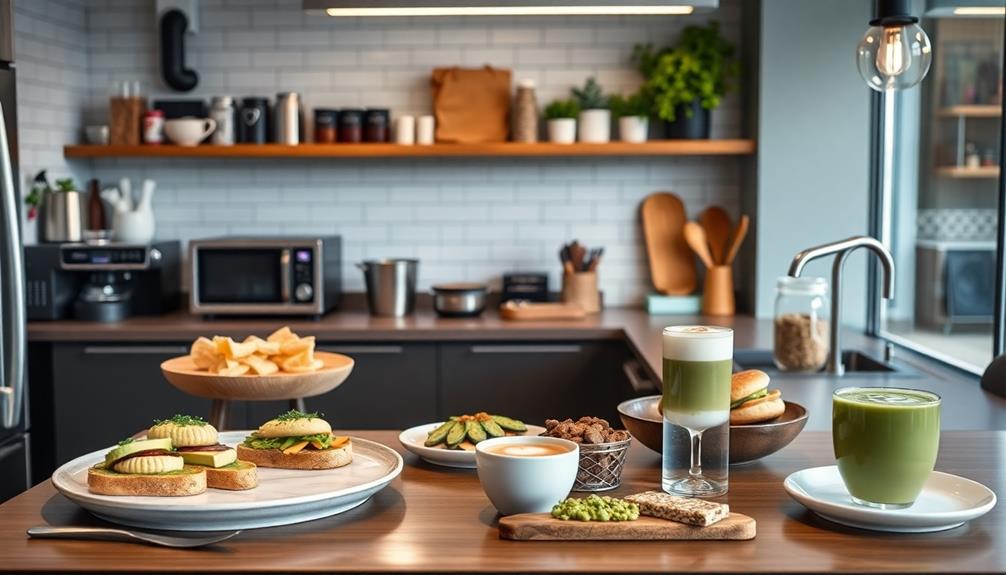
Embracing evolving food trends in tech culture, many individuals are gravitating toward foods that not only taste good but also reflect their values. Foods like organic cold-pressed juices and artisanal coffee have emerged as status symbols, showcasing a commitment to wellness and high-quality ingredients.
You might notice how these choices signal affluence and a discerning palate among your peers. Seasonal dishes, such as Nettle and Potato Soup, exemplify a connection to local farming practices and an appreciation for fresh, nutritious ingredients.
The rise of plant-based diets, featuring gourmet vegan meals and specialty meat alternatives, highlights a growing preference for sustainability. This trend resonates with tech-savvy individuals who prioritize ethical consumption.
Premium snacks, such as high-protein, low-carb options, often crafted by small-batch producers, add an aspirational flair to your snacking routine.
Moreover, memberships to exclusive food clubs or subscription services offering curated selections of gourmet foods illustrate a desire for unique culinary experiences that elevate your social standing.
As you participate in the clean eating movement, choosing non-GMO and locally sourced ingredients, you further align your eating habits with your ethical beliefs.
In this way, the foods you consume not only nourish you but also serve as powerful status symbols within the tech community, reflecting your values and lifestyle choices.
The Role of Health Consciousness
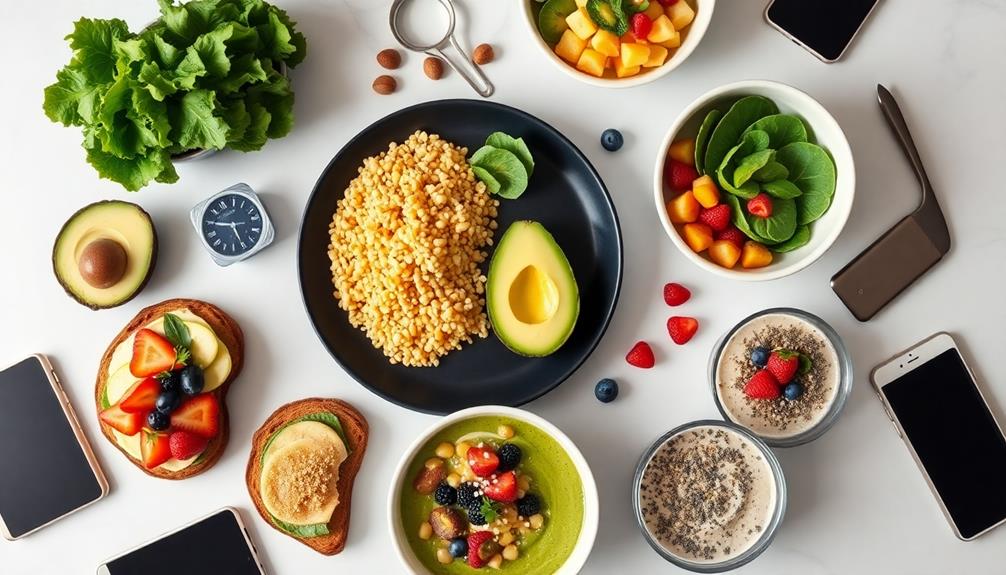
Health consciousness has skyrocketed in recent years, transforming how you and your peers approach food choices. You're not just grabbing whatever's available; you're seeking out pure foods that reflect your commitment to a healthier lifestyle.
Ethnic cuisines, such as Indian meals like Mushroom Masala, with their rich flavors and vegetarian-friendly options, are becoming increasingly popular among health-conscious individuals. With around 5% of the population willing to spend more for unadulterated options, it's clear that food quality is intertwined with social status.
For instance, unhomogenized milk priced at $1.75 per half-gallon symbolizes luxury among affluent individuals, reinforcing the idea that health-conscious choices are both sophisticated and aspirational.
The demand for pure foods, driven largely by 75 million Americans—especially affluent young professionals and educated students—highlights how health consciousness fuels social mobility.
You might notice that when you choose high-quality, health-oriented foods, you're not just eating; you're making a statement about your values and awareness.
This shift towards prioritizing nutrition and food safety reflects a growing trend where your food purchases act as a reflection of your personal image, with health consciousness emerging as a key status symbol in tech culture.
Sustainability as a Status Indicator
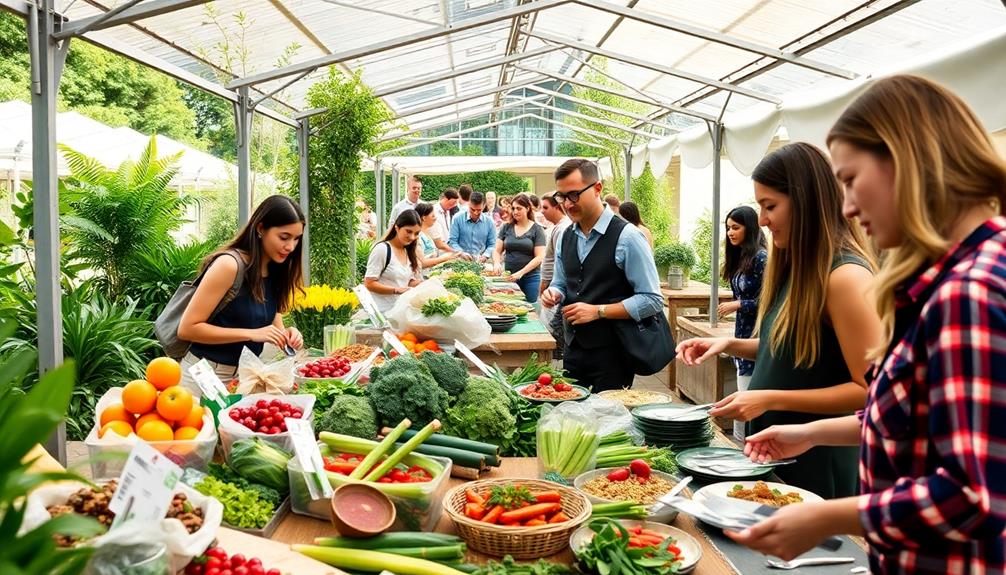
In today's tech culture, your choices reflect your values, and sustainability has become a key status indicator. As individuals increasingly seek out local ingredients and sustainable practices, the influence of diverse culinary traditions, such as Brazilian Cuisine, showcases how food can embody eco-consciousness.
Whether you're opting for thrifted vintage pieces, organic local foods, or embracing minimalism, each decision signals a commitment to mindful consumption. As more people prioritize eco-friendly practices, these choices not only enhance your lifestyle but also elevate your social standing.
Thrifting and Vintage Appeal
Thrifting has become more than just a budget-friendly shopping option; it's now a cultural statement that reflects a commitment to sustainability and individuality. For you, thrifting isn't just about saving money—85% of your peers feel the same way, and 42% are motivated by sustainable practices. With 83% of Gen Z participating in secondhand shopping, it's clear that vintage appeal is on the rise.
Rather than opting for traditional luxury goods, you and many others prefer unique, one-of-a-kind items that tell a story. In fact, 47% of individuals see thrifting as a trendy choice, showcasing a shift in status symbols. This growing trend emphasizes the importance of authenticity over mere branding.
Brands that genuinely prioritize sustainability resonate with you, especially as skepticism about luxury labels' sustainability claims grows. You value circular innovation and are drawn to products that align with your beliefs about climate change and mental health.
Ultimately, thrifting reflects your individuality while signaling a broader cultural movement that prioritizes genuine commitment over superficial appearances. In this way, thrifting has become an essential part of modern tech culture's status symbols.
Organic and Local Choices
Embracing organic and local food choices has transformed into a powerful status symbol within tech culture, reflecting a deeper commitment to sustainability and ethical consumption.
As you navigate this landscape, you'll notice that consuming organic foods—like unhomogenized milk and cage-free eggs—has become a hallmark of exclusivity. These premium options often come with price tags that are 25-40% higher than conventional alternatives, signaling not just a taste for quality, but a higher social standing.
This trend is particularly pronounced among affluent consumers and young professionals. About 5% of the population actively seeks organic and local options, indicating a significant economic shift.
The specialty food market, valued between $3 to $10 billion, underscores this movement towards higher-quality, sustainable food choices.
Moreover, consumers like you increasingly associate food quality with personal image and social mobility. Brands targeting tech-savvy individuals must prioritize transparency in sourcing and emphasize health and wellness.
Minimalism and Mindful Consumption
Minimalism and mindful consumption have become essential trends in tech culture, where you're encouraged to prioritize experiences and sustainable products over the clutter of excessive material goods.
This shift reflects a growing desire for guilt-free consumption and eco-conscious living, making sustainability a status symbol among the tech-savvy crowd.
Here are three ways minimalism and mindful consumption manifest in your life:
- Secondhand Shopping: With 83% of Gen Z engaging in secondhand shopping, you're likely to find economic and sustainable benefits, reducing waste while embracing unique finds.
- Pure Foods: You're drawn to foods marketed as unadulterated and ethically sourced. These premium options not only taste better but also signal your commitment to quality and transparency.
- Sustainable Brands: Supporting brands that prioritize sustainability and circular innovation shows your alignment with eco-conscious values, elevating your status among peers who appreciate mindful choices.
As societal attitudes evolve, your choices reflect a deeper commitment to minimalism and sustainability, transforming how you view consumption and status in tech culture.
Exclusive and Artisanal Offerings

In the domain of tech culture, exclusive and artisanal offerings have become the ultimate culinary status symbols. When you opt for handcrafted cheeses or small-batch chocolates, you're not just choosing a snack; you're embracing a lifestyle that prioritizes quality and rarity. These foods often command higher prices, appealing to consumers who value uniqueness in their culinary experiences.
The rise of food subscription services showcasing curated artisanal products reflects your desire for exclusive offerings that align with your values of craftsmanship and ethical consumption. Limited-edition items, like rare truffles or specialty coffees sourced from specific regions, serve as status symbols, emphasizing your access to premium products.
Moreover, many tech-savvy consumers, including yourself, gravitate towards sustainably sourced and produced artisanal foods, mirroring a cultural shift towards environmental consciousness.
The integration of technology in food production—like apps that connect you with local artisans or farmers—enhances the appeal of these exclusive foods, reinforcing their status as luxury items in your world. By choosing these offerings, you're not just eating; you're making a statement about your identity and values within the tech culture.
Social Media Influence on Food Choices

Social media has transformed how you choose what to eat, turning visually stunning dishes into coveted status symbols. You're not just eating; you're curating an online persona.
Platforms like Instagram and TikTok play a huge role in shaping your food preferences, as influencers promote trendy and premium options that often come with a hefty price tag. The social media influence on food choices is undeniable, particularly among younger generations.
Consider these key points:
- Visual Appeal: Dishes like avocado toast and artisanal smoothies thrive on social media, driving trends with hashtags like #foodporn.
- Gen Z Engagement: Over half of Gen Z is influenced by social media in their food decisions, showcasing the power of online visuals.
- Exclusive Offerings: The rise of "Instagrammable" foods prompts restaurants to craft unique menu items aimed at attracting social media attention.
As dining becomes a showcase for online status, you find yourself drawn to experiences that reflect evolving values in tech culture.
It's no longer just about flavor; it's about the image and social capital that comes with each meal.
Experience Over Ownership in Dining
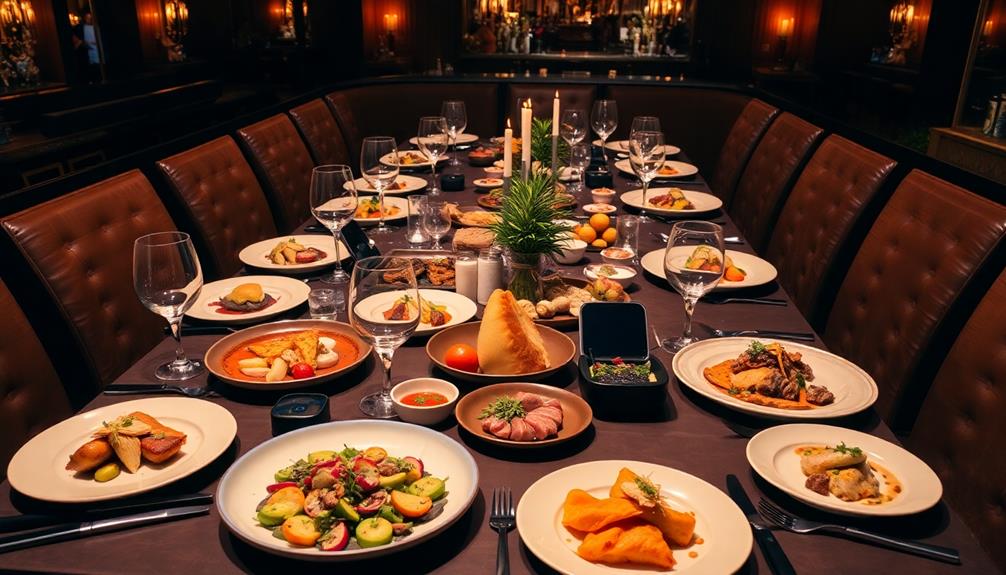
When you think about dining today, it's not just about the food; it's about the entire experience.
Exclusive dining spots and trendy food aesthetics have become the new status symbols, especially on social media.
As you share those visually stunning meals online, you're not just eating—you're showcasing your social standing.
Exclusive Dining Experiences
Exclusive dining experiences have emerged as a powerful status symbol in tech culture, reflecting a shift toward valuing unique culinary adventures over mere ownership of material goods. For many in this community, dining isn't just about food; it's a chance to showcase individuality and social capital.
Consider these points:
- Memorable Moments: A staggering 58% of Gen Z consumers prioritize unforgettable dining experiences, viewing them as a form of self-expression.
- Social Media Buzz: With 76% of diners sharing their culinary outings online, exclusive dining experiences gain prestige, amplifying their status symbol appeal.
- Connection: For 63% of millennials and Gen Z, enjoying high-end meals together fosters deeper connections, reinforcing the social currency tied to these experiences.
In this way, exclusive dining experiences aren't just meals, but events that enhance your social narrative.
The allure of Michelin-starred restaurants or themed pop-up events offers more than just food; it's about belonging to a community that values the extraordinary.
As these culinary adventures continue to rise in prominence, they solidify their place as essential status symbols in tech culture.
Trendy Food Aesthetics
Colorful dishes adorned with edible flowers and intricate designs have become the hallmark of trendy food aesthetics, enchanting diners and social media users alike. You're not just ordering food; you're curating an experience that doubles as a status symbol.
With 71% of Gen Z stating they're more likely to choose visually appealing meals, it's clear that dining is all about self-expression and social currency.
The rise of "Instagrammable" food, like elaborate smoothie bowls and artisanal coffees, reflects a significant shift in your dining preferences. Rather than simply consuming meals, you prioritize unique presentations that are worthy of sharing online.
This trend emphasizes sustainability and creativity, as many young consumers, 83% of whom engage in secondhand shopping, seek local eateries that offer innovative and eco-friendly options.
As dining evolves into memorable experiences, brands that focus on aesthetic presentation can foster customer loyalty. You see this in the 42% of young diners motivated by sustainability in their food choices.
Ultimately, sharing unique food experiences online transforms dining into a status symbol, making thrifted or unique items trendy and desirable.
Social Media Influence
The way you choose where to dine has shifted dramatically thanks to social media's influence. Dining isn't just about the food anymore; it's about the experience you can share with your followers. Unique and visually appealing dishes are now essential for attracting attention, pushing you to seek out restaurants that serve "Instagrammable" foods.
Here are three ways social media dictates your dining choices:
- Visual Appeal: You're drawn to colorful smoothie bowls and elaborate desserts that make for striking photos.
- Value Alignment: With 42% of Gen Z prioritizing sustainable and ethically sourced options, restaurants that reflect these values become more desirable status symbols.
- Trending Spots: Dining at high-profile restaurants featured in social media feeds has become a symbol of prestige, shifting the focus from ownership of luxury goods to the shared experience of dining.
Research shows that 71% of young consumers let social media influence their dining decisions, indicating that an engaging online presence can make or break a restaurant's status.
In this tech-driven age, the experience you share online holds more weight than ever.
Generational Shifts in Food Perception
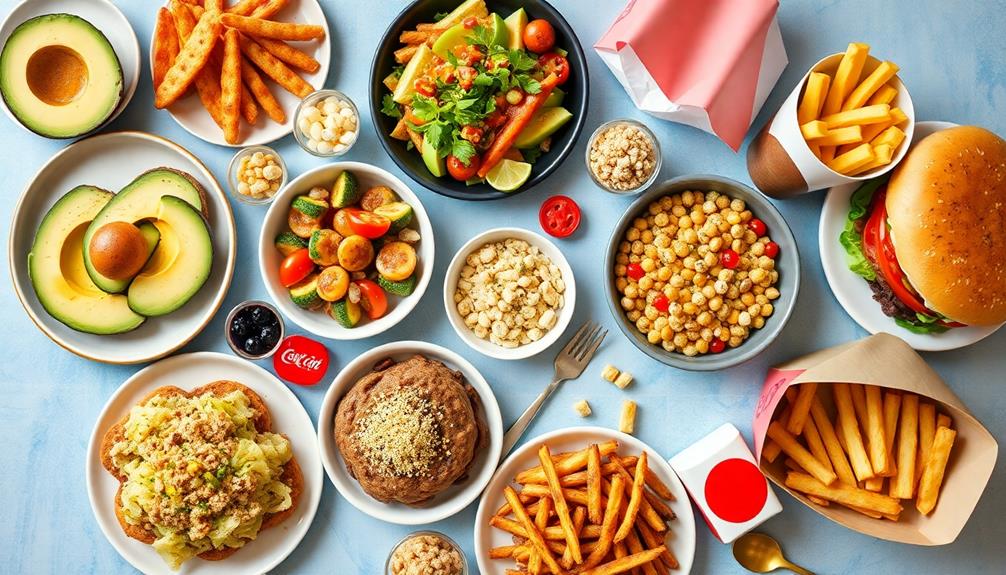
Shifting toward more health-conscious choices, younger generations, particularly Gen Z, are redefining what it means to eat well. Unlike previous generations, you prioritize organic and pure foods as status symbols, reflecting a deeper commitment to health and sustainability. You recognize that what you consume says a lot about your values, and this trend is reshaping food culture.
With 83% of Gen Z engaging in secondhand shopping, you demonstrate a preference for ethical practices that extend to your food choices. When you opt for premium organic products, you're not just choosing quality; you're making a statement about your lifestyle.
The specialty food market, worth between $3 to $10 billion, underscores this shift as you and your peers seek high-quality, health-oriented options that signify social class and sophistication.
Younger generations, especially young professionals, associate pure foods with personal image enhancement and upward mobility. By investing in these premium choices, you align your diet with your aspirations, reinforcing a narrative that health and sustainability are the new luxury.
In this evolving landscape, your food choices reflect not just nutritional values but also your social identity.
Intersection of Identity and Food
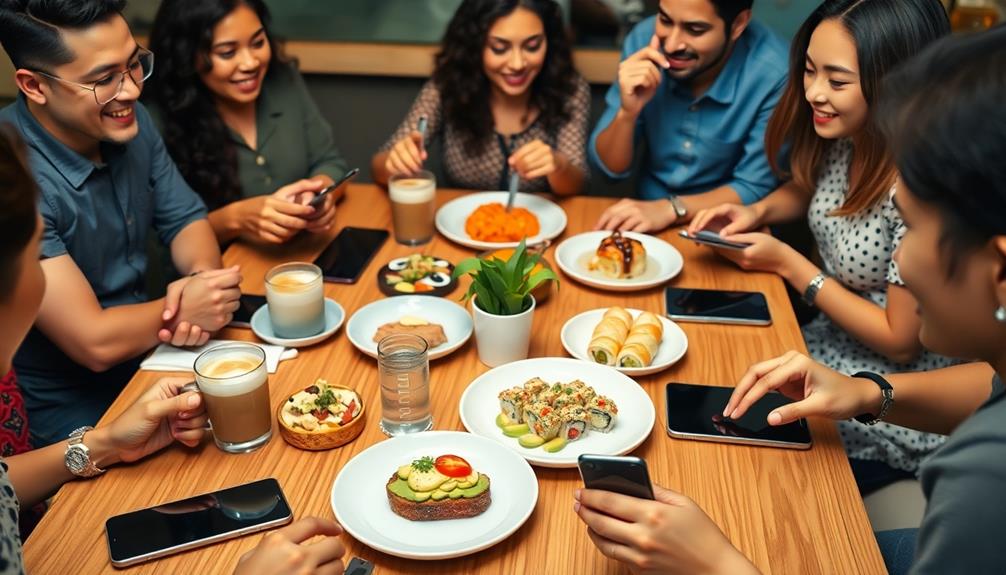
In tech culture, food choices are more than just sustenance; they're a reflection of identity and values. The foods you choose often serve as status symbols, demonstrating your commitment to health, sustainability, and quality.
As you navigate this landscape, consider how your selections connect to broader trends and personal beliefs.
- Organic and Artisanal Products: These foods signal an allegiance to eco-consciousness and wellness, showcasing your dedication to high-quality ingredients.
- Clean Eating Trends: By prioritizing transparency and sourcing, you align with the 95% of consumers wanting to know where their food comes from, reinforcing your values.
- Gourmet Experiences: High-end items like cold-pressed juices and specialty coffee reflect sophistication and status, particularly among millennials and Gen Z, who are willing to pay a premium for quality.
In this way, your food choices become a powerful means of self-expression.
As you share these experiences on social media, you cultivate a personal brand that resonates with your identity, aligning your dietary habits with the values of a tech-driven society.
Frequently Asked Questions
What Are Considered Status Symbols?
Status symbols include luxury items like designer clothing, high-end gadgets, exclusive memberships, and unique experiences. When you own or showcase these, you signal your success and social standing, influencing how others perceive you.
Is Food the New Status Symbol?
Absolutely, food's become a new status symbol. You express your identity and values through your choices, showcasing commitment to health and sustainability. When you choose trendy, artisanal options, you signal your lifestyle aspirations to others.
How Does a Product Become a Status Symbol?
A product becomes a status symbol when you perceive it as rare and exclusive. Marketing, cultural trends, and social media shape this perception, while high prices and quality reinforce its desirability among consumers like you.
What Are the Status Symbol Goods?
Status symbol goods include luxury items like designer handbags, high-end watches, organic foods, and premium kitchen appliances. You'll notice these products often reflect your wealth, taste, and commitment to quality and exclusivity in your lifestyle.
Conclusion
In the fast-paced domain of tech culture, the foods you choose can say more than you think. As trends shift and sustainability takes center stage, your next meal might just reveal your values. Imagine, for a moment, the impact of that exclusive artisanal dish or trendy superfood on your social standing. The question lingers: what does your plate truly reflect about you? In this evolving landscape, the answer could redefine not just your meals, but your very identity.
Lifestyle
The Unexpected Ways Soil Microbiomes Affect Crop Flavors
An exploration of how soil microbiomes influence the flavors of crops reveals surprising connections that could change the way we think about agriculture.
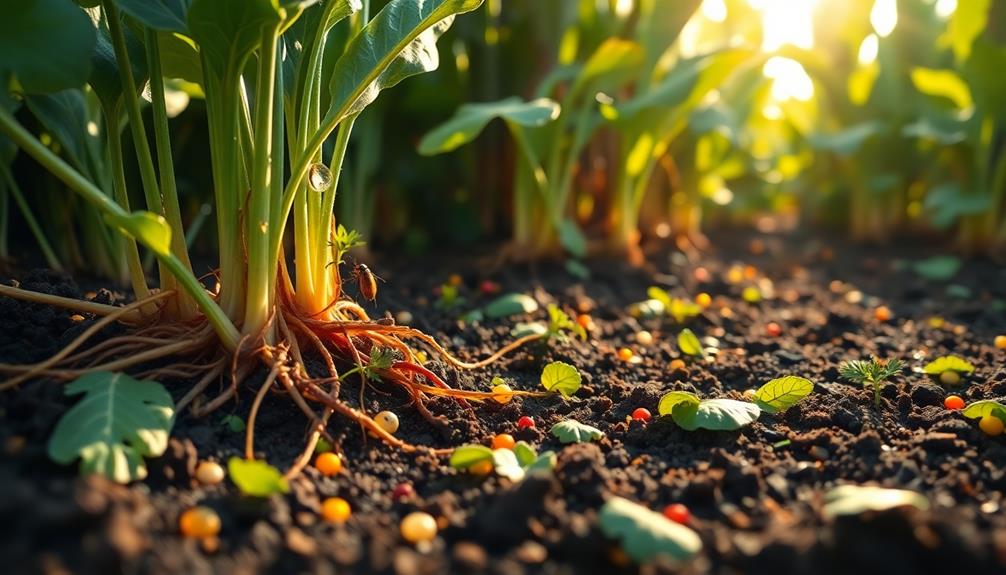
Soil microbiomes surprisingly shape the flavors of your crops by influencing nutrient absorption and the synthesis of flavor compounds. Diverse microorganisms improve nutrient availability, which directly affects taste quality. For instance, specific microbes boost glucosinolates, enhancing spiciness in crops like mustard. Healthy soils with rich organic matter lead to more vibrant flavors as these microbes interact with roots to support plant health. Additionally, crucial minerals in the soil, such as selenium and zinc, play a crucial role in flavor development. Discovering the intricate links between soil health and crop flavor can reveal even more fascinating insights.
Key Takeaways
- Soil microbiomes enhance the synthesis of flavor compounds by modulating biochemical pathways, particularly increasing glucosinolates in crops like mustard and Brassica.
- Microbial diversity in the soil directly influences the chemical composition of crops, resulting in variations in flavor intensity and quality.
- Nutrient-rich soils, supported by healthy microbial communities, improve crop absorption of essential minerals, which significantly enhance flavor profiles.
- Specific soil microbes can alter root-microbe interactions, stimulating the production of phytohormones that contribute to flavor compound synthesis in plants.
- Soil amendments and microbial probiotics can boost phytochemical concentrations, further enhancing flavor characteristics in various crops.
Understanding Soil Microbiomes
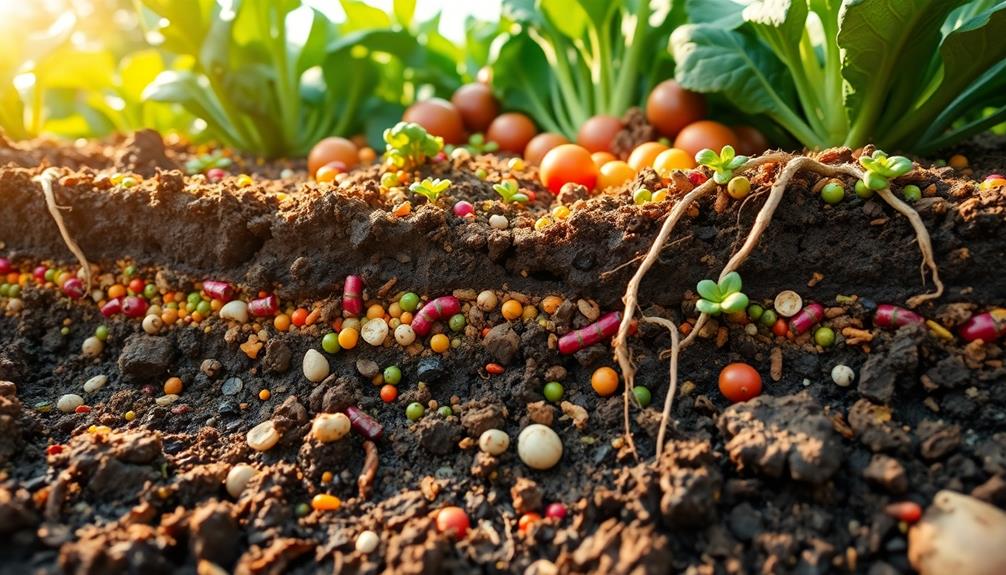
Soil microbiomes, teeming with diverse microorganisms like bacteria and fungi, play an indispensable role in nutrient cycling and plant growth. These microbial communities are essential for breaking down organic matter, making nutrients available for plants, and fostering healthy soil ecosystems.
When you cultivate crops, you're not just nurturing the plants; you're also supporting these important microorganisms that help shape your harvest.
The interactions between soil microbiomes and crops can be as rich and diverse as Brazilian cuisine, where various cultural influences create unique flavors traditional dishes. Understanding soil microbiomes helps you recognize their impact on plant health and flavor.
For example, specific microbes can enhance nutrient availability, influencing secondary metabolites in plants, which contribute to taste and aroma. In crops like mustard, certain bacteria boost glucosinolate levels, intensifying spiciness and unique flavor profiles.
Changes in environmental conditions or amendments can alter these microbial communities, leading to variations in chemical profiles that affect both flavor and nutritional value.
Role of Microbes in Flavor Development
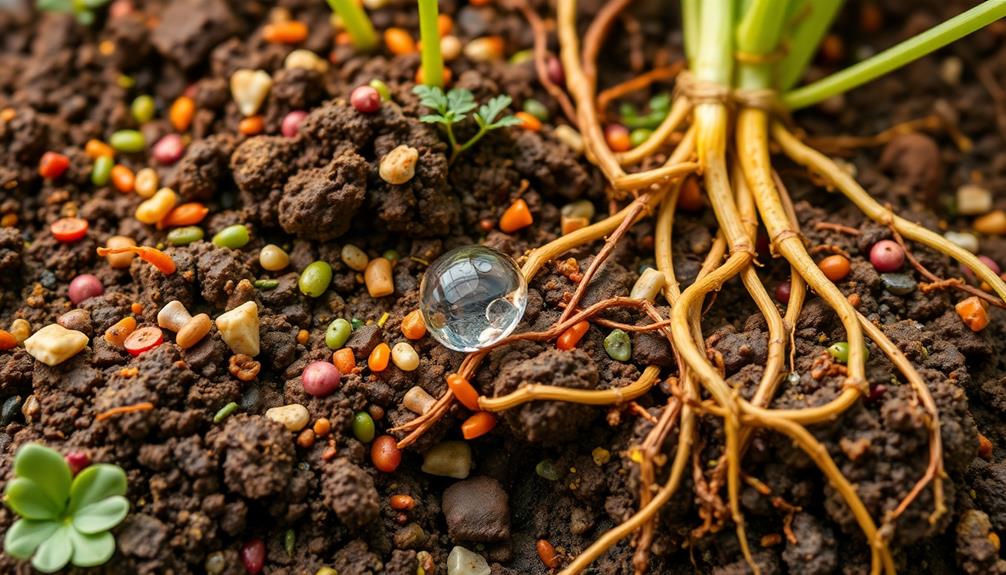
Microbes play a vital role in shaping the flavors of the crops you grow. The soil microbiome markedly influences the concentration of plant secondary metabolites, like glucosinolates, which are fundamental for the distinct taste and aroma of crops such as mustard and other Brassica family vegetables.
Specific soil microbes can enhance the spiciness of mustard seeds by affecting the biochemical pathways involved in glucosinolate production. This connection links soil health to flavor profiles, highlighting the importance of a diverse microbial community. Notably, just as the rich flavors of Red-Braised Pork Belly benefit from careful ingredient combinations, the flavors of crops can be greatly enhanced by the right microbial interactions.
When soil microbes interact with plant roots, they not only improve nutrient uptake but also impact the synthesis of flavor compounds, directly affecting crop taste quality. Research shows that variations in microbial diversity can lead to differences in the chemical composition of crops, resulting in changes in flavor intensity and nutritional value.
Additionally, preliminary evidence suggests that applying microbial probiotics to your soil might enhance desirable flavor characteristics in your crops. This could improve marketability and align with consumer preferences for flavorful vegetables, making the role of microbes in flavor development essential for both taste and agricultural success.
Nutrient Uptake and Crop Quality
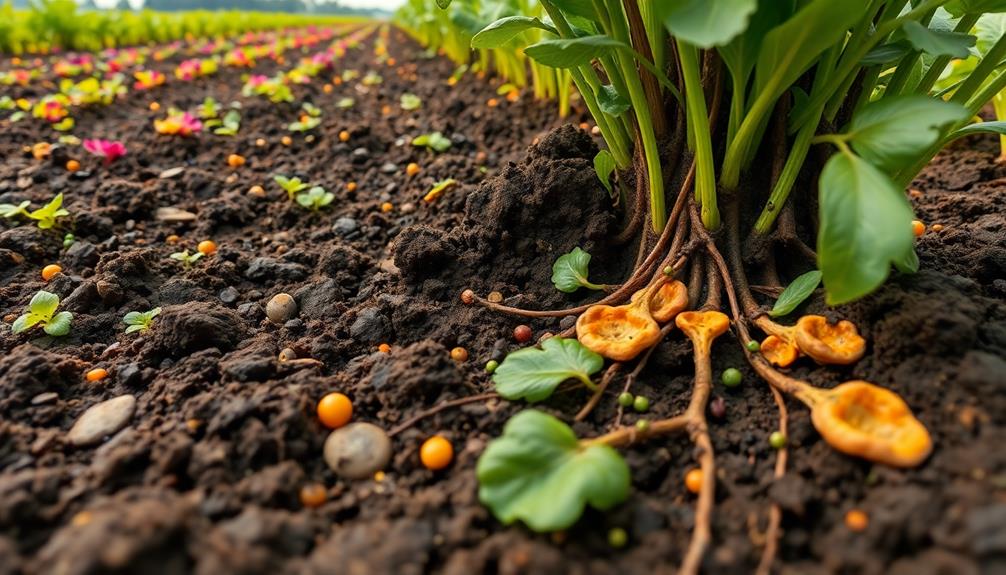
The nutrient composition of your soil directly affects how well your crops absorb essential minerals, which in turn influences their taste and quality.
For instance, crops like heirloom beans can showcase enhanced flavors when grown in nutrient-rich soil, highlighting the importance of soil health in celebrating culinary traditions.
When you maintain a healthy balance of nutrients, like selenium and zinc, you can enhance the flavor profiles of your fruits and vegetables.
Plus, the right soil microbes play a vital role in improving nutrient uptake, leading to tastier and more robust crops.
Soil Nutrient Composition
Nutrient composition in the ground plays an essential role in determining the flavors of the crops you grow. The levels of essential soil nutrients like selenium, zinc, and magnesium greatly impact the taste and nutritional value of your produce. When plants absorb these nutrients, they directly influence the chemical compounds that contribute to flavor and aroma.
Soil pH and organic matter content also affect nutrient uptake, shaping the overall quality of the crops you produce. Rich organic soil is linked to stronger, more robust flavors, emphasizing the need to maintain soil health for ideal crop production. Specific nutrients, especially nitrogen, are pivotal in synthesizing flavor compounds, helping develop the desirable taste attributes in fruits and vegetables.
Additionally, the soil microbiome plays an important role in nutrient cycling, ensuring the availability of these key nutrients. A healthy microbial community can enhance nutrient uptake, ultimately improving the flavor and quality of your crops.
Microbial Influence on Flavors
Understanding soil nutrient composition lays the groundwork for exploring how microbial communities influence crop flavors.
The soil microbiome plays an essential role in nutrient uptake, directly impacting the quality and taste of your crops. By fostering diverse microbial life, you can enhance the production of plant metabolites, which are vital for flavor development.
Here are some ways microbial influence can shape crop flavors:
- Improved Nutrient Absorption: Microbial communities help plants access essential nutrients and water more effectively.
- Flavor Compound Production: Specific minerals like selenium, zinc, and magnesium can boost the flavor profiles of your crops.
- Enhanced Glucosinolates: Research shows that diverse soil microbiomes increase glucosinolates, adding spiciness to Brassica family crops like mustard.
- Microbial Inoculants: Applying these can shift microbial dynamics, resulting in higher concentrations of beneficial plant metabolites.
Impact of Soil Health on Taste
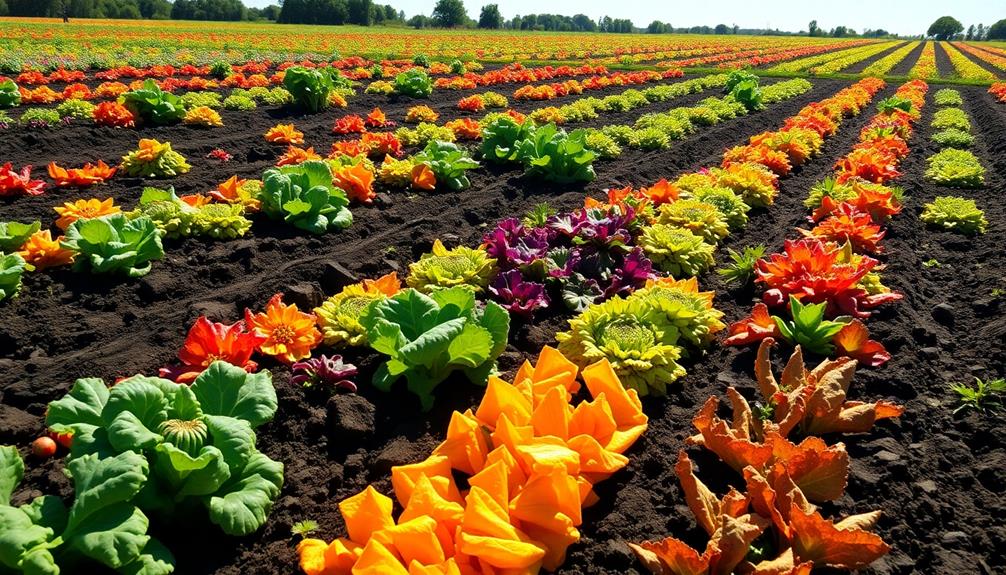
Soil health plays an essential role in determining the taste of your crops.
When you guarantee rich, diverse soils with the right minerals and microorganisms, you'll likely notice more vibrant flavors in your fruits and vegetables.
Understanding how soil composition directly influences flavor can help you grow tastier produce.
Microbial Influence on Flavor
The intricate relationship between microbial communities in the ground and the flavors of the crops you enjoy is fascinating.
These soil microbial communities directly influence the taste profiles of your favorite fruits and vegetables by affecting nutrient absorption and promoting the production of flavor compounds.
Here's how they work their magic:
- Organic matter: Rich organic soils foster healthier microbial life, leading to stronger, more robust flavors.
- Flavor compounds: Microbes can alter biochemical pathways in plants, enhancing compounds like glucosinolates, which contribute to unique tastes.
- Mineral content: Specific minerals, such as selenium, zinc, and magnesium, enhance flavors, proving that the right soil composition matters.
- Diversity in microbes: Unique microbial inoculums can impact the spiciness of crops, as seen in mustard seeds, showcasing the connection between soil health and flavor chemistry.
Maintaining a healthy soil microbiome is essential for ideal nutrient absorption, which in turn affects the levels of flavor compounds in your crops.
Soil Composition and Taste
Microbial communities play a pivotal role in shaping how we experience flavors, but their influence doesn't stop there. The composition of soil is essential in determining the taste of the crops you enjoy. Variations in mineral content, pH levels, and moisture directly affect how plants absorb taste-related compounds. For instance, nutrient-rich soils—those loaded with minerals like selenium, zinc, and magnesium—can enhance the intensity and quality of flavors in vegetables and fruits.
Healthy soil ecosystems, characterized by diverse microbial life, are critical for robust plant growth. These microorganisms facilitate improved nutrient uptake, leading to stronger flavors. A rich organic soil, filled with organic matter, lays the groundwork for healthier microbial populations, which in turn support flavorful compound production in crops.
Additionally, the health of the soil directly impacts the concentration of glucosinolates in plants from the Brassica family, like mustard and broccoli. These compounds contribute to the characteristic spicy and bitter notes that many love.
Microbial Diversity and Crop Variability

A rich diversity of microbes in the soil greatly shapes the flavor profiles of crops you might grow. This microbial diversity influences the synthesis of flavor compounds, which are essential to how your plants taste.
Variability in soil composition, including nutrient levels and organic matter, directly affects which microbial populations thrive, thereby impacting crop performance and flavor quality.
Here are some key points to bear in mind:
- Specific soil microbes can enhance glucosinolates in Brassica crops, adding spicy and bitter notes.
- Diverse microbial inoculants can increase flavor intensity in crops like mustard.
- The interaction between soil microbes and plant roots alters biochemical pathways responsible for flavor development.
- Maintaining a healthy and varied soil microbiome is vital for ideal flavor quality.
The Connection Between Soil and Aroma
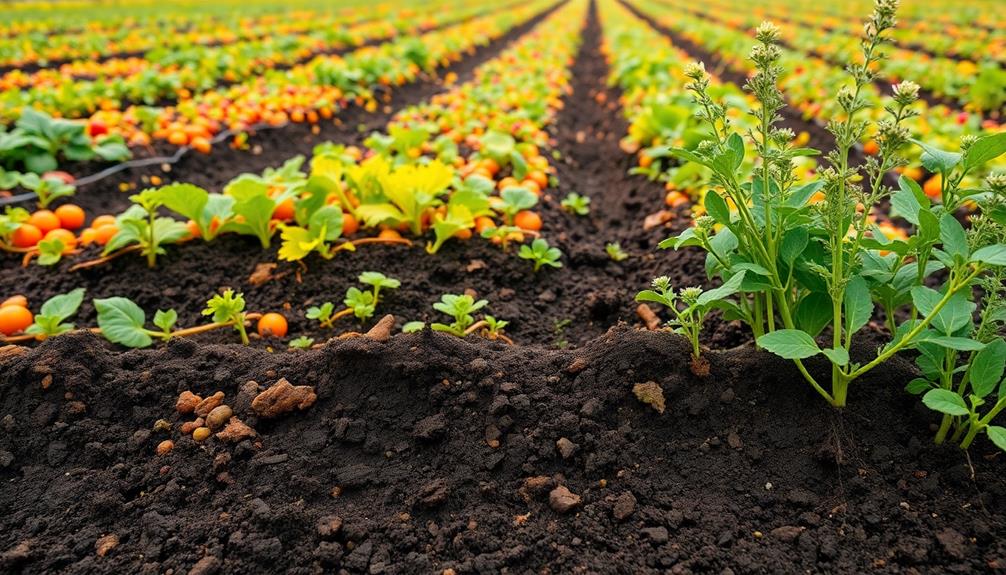
Flavor isn't just about taste; aroma plays an equally essential role in how you experience your food. The connection between soil and aroma is profound, as the characteristics of the soil directly influence the flavor profiles of food crops.
Healthy soil, rich in organic matter and minerals like selenium, zinc, and magnesium, enhances nutrient absorption, leading to the production of aromatic compounds in plants.
The microbial community within the soil is vital here. These microbes help determine the chemical composition of crops, influencing the biosynthesis of flavor-related compounds. For example, in Brassica species, soil microbes can greatly impact the production of glucosinolates, which contribute to their distinctive aroma and taste.
Research shows that crops grown in rich organic soils tend to exhibit stronger, more robust flavors. This indicates that a thriving soil microbiome can lead to enhanced food flavor, making your meals more enjoyable.
Additionally, manipulating soil microbiomes through microbial inoculants presents an exciting opportunity to improve flavor intensity, ultimately giving you more flavorful produce.
Soil Amendments and Flavor Enhancement
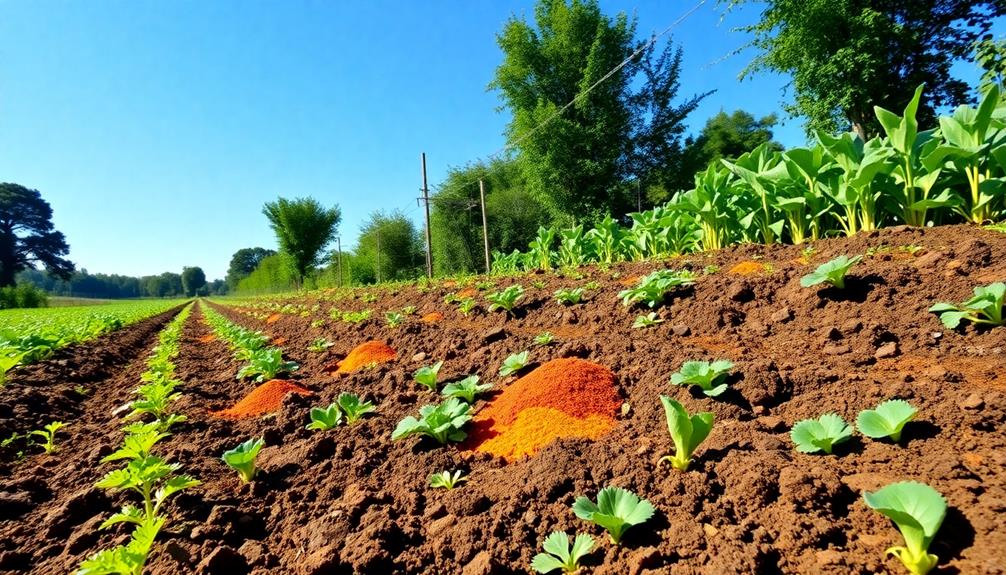
Soil amendments can greatly boost the flavor profiles of your crops, transforming the way you experience your food. By introducing the right soil amendments, you can enhance the microbial community in your garden, which plays a vital role in flavor enhancement.
Here are some effective amendments to take into account:
- Microbial probiotics: These can increase phytochemical concentrations, like glucosinolates in mustard plants.
- Organic sludges: Adding these can improve microbial diversity, correlating with better flavor characteristics in fruits and vegetables.
- Essential minerals: Nutrients such as selenium, zinc, and magnesium can greatly enhance crop flavors.
- Compost: This can modulate existing microbial communities, leading to improved taste and nutritional value in crops like strawberries.
When you focus on your soil's composition and utilize the right amendments, you not only boost crop productivity but also elevate the taste experience of your harvest.
Research shows that these changes in the microbial community can directly impact nutrient uptake, influencing the aroma and flavor of the food you grow.
Embrace soil amendments, and you'll be delighted by the flavors that await your palate!
Microbial Interactions With Plant Roots
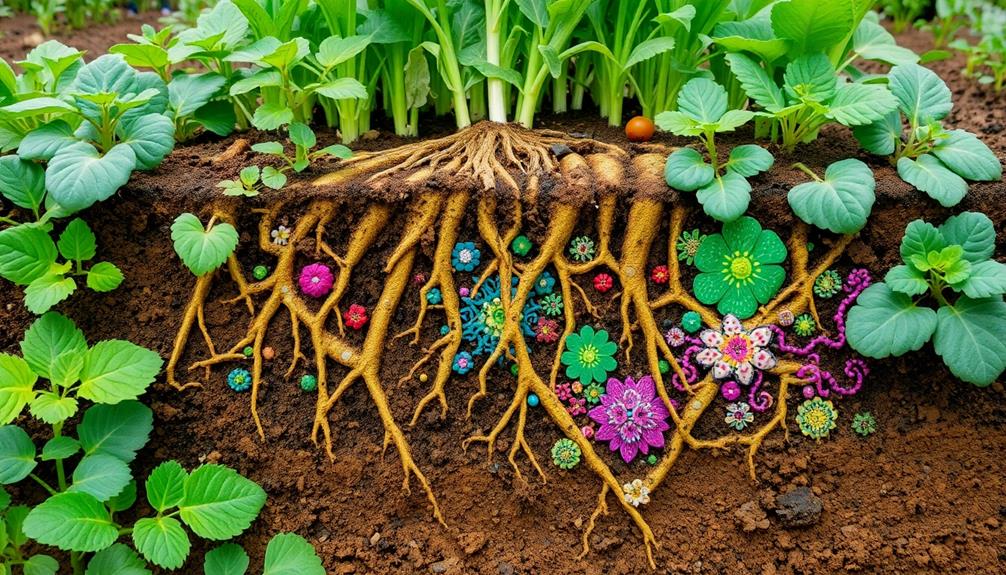
When you consider the relationship between plants and their root microbiomes, you can see how microbial diversity plays an essential role in flavor compound synthesis.
These microorganisms enhance nutrient uptake mechanisms, which not only supports plant health but also influences the taste of the crops you enjoy.
Understanding these interactions can give you insights into how soil health directly affects food flavor.
Root Microbiome Diversity
Exploring the root microbiome reveals a complex world of microbial interactions that greatly influence plant health and flavor. The diversity of microorganisms associated with plant roots plays a pivotal role in shaping the chemical composition of flavor compounds.
When you consider the following aspects, you'll appreciate just how critical this diversity is:
- Root growth: A rich microbial community can enhance root development, leading to healthier plants.
- Soil management: Practices that promote microbial diversity can optimize nutrient availability and uptake.
- Microbial diversity: Higher diversity often correlates with more intense and complex flavors in crops.
- Flavor compounds: Specific interactions, like those between rhizobacteria and plant roots, can boost the production of flavor-related metabolites.
Flavor Compound Synthesis
The interactions between soil microbiomes and plant roots greatly influence the synthesis of flavor compounds in crops. Beneficial microbial communities, particularly plant growth-promoting rhizobacteria (PGPR), play an essential role in enhancing flavor by stimulating the production of phytohormones and secondary metabolites.
For instance, in plants from the Brassica family, such as mustard, specific microbes can increase the production of glucosinolates, which contribute to their distinct spicy and bitter flavors.
Research indicates that the presence of diverse microbial inoculants can markedly alter the flavor profile of crops, demonstrating a direct correlation between microbial diversity and flavor compound synthesis.
Additionally, certain soil minerals like selenium and zinc, facilitated by these microbial communities, enhance the biosynthesis of flavor compounds.
The complexity of soil microbiomes means that flavor compound synthesis can evolve over time. As microbial communities change throughout the growing season, so can the chemistry and flavor of your crops.
Nutrient Uptake Mechanisms
Enhancing nutrient uptake, soil microbes play an essential role in plant health and flavor development. By interacting with plant roots, these microorganisms create favorable conditions for nutrient absorption, which is vital for producing rich flavor compounds in crops.
Here's how soil microbes enhance nutrient uptake:
- Phytohormone Production: They stimulate root growth, increasing surface area for better nutrient absorption.
- Mycorrhizal Partnerships: Fungi form symbiotic relationships with roots, greatly boosting the absorption of essential nutrients like phosphorus and nitrogen.
- Drought Tolerance: Beneficial rhizobacteria, such as Paenibacillus polymyxa, regulate gene expression to enhance both water and nutrient uptake, improving plant resilience.
- Siderophore Secretion: Certain microbes bind to iron in the soil, facilitating its uptake by plants, which can enhance growth and flavor profiles.
These interactions not only support effective nutrient uptake but can also alter metabolic processes in plants.
The result? Changes in the concentrations of flavor compounds, like glucosinolates in mustard plants.
Case Studies in Flavor Variation
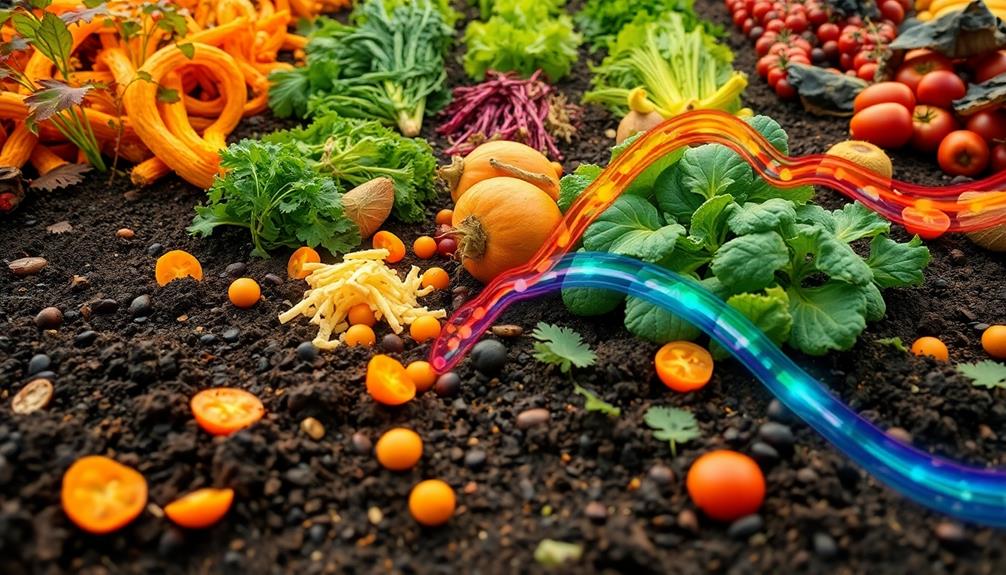
While investigating the intricate relationship between soil microbiomes and crop flavors, researchers have uncovered compelling case studies that showcase significant variations in taste. One standout experiment focused on mustard plants, where different microbial communities dramatically altered flavor profiles. Mustard inoculated with microbes from aspen groves exhibited a spicier taste, thanks to higher glucosinolate concentrations, while those from agricultural pastures produced milder flavors.
The following table illustrates these intriguing findings:
| Microbial Source | Flavor Profile |
|---|---|
| Aspen Groves | Spicy |
| Agricultural Pastures | Mild |
| Diverse Microbial Mix | Varies |
| Control Group | Neutral |
These variations underline the importance of soil microbiomes not just for plant health but also for the sensory attributes of crops. As the study progressed, researchers encountered challenges with evolving microbiomes, highlighting the complexity of microbial interactions. Preliminary evidence even suggests that specific soil microbes could enhance spiciness, hinting at the potential for microbial probiotics to improve crop flavor attributes. This research truly emphasizes the nuanced role of microbial diversity in shaping our food experiences.
Future Research Directions in Flavor Science
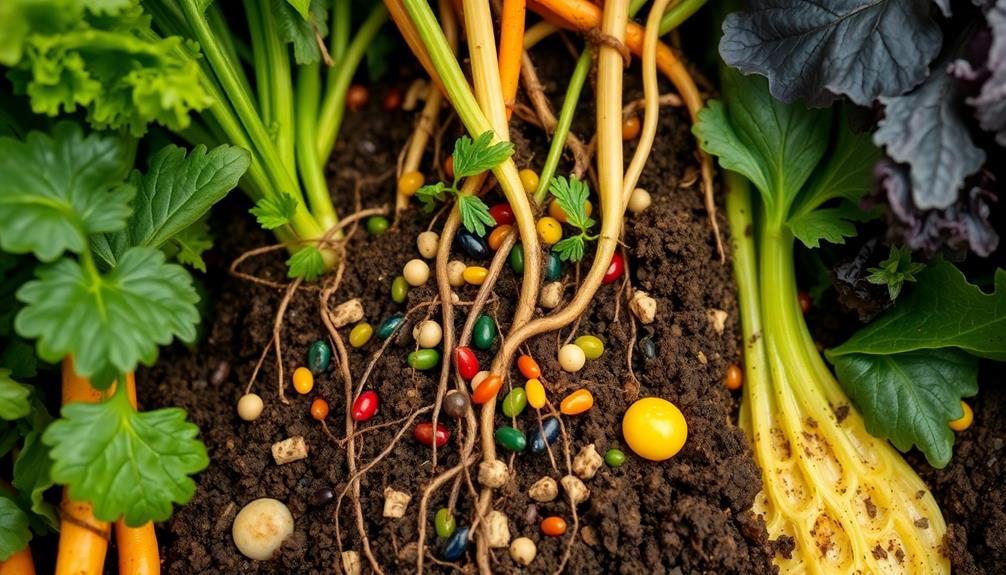
Research into the relationship between soil microbiomes and crop flavors has opened up exciting avenues for future investigation. As you immerse yourself in this field, contemplate exploring the intricate dynamics between specific soil microbial communities and the flavor profiles of various crops.
Here are some key research directions to ponder:
- Microbial Diversity: Investigate how different microbial populations can enhance flavor compounds, such as glucosinolates in Brassica species.
- Soil Amendments: Study the effects of various soil amendments on microbial communities and their subsequent impact on crop flavor and nutritional quality.
- Plant Metabolism Mechanisms: Understand how soil microbes influence plant metabolism, particularly in synthesizing volatile compounds that contribute to flavor.
- Abiotic Factors: Examine how soil composition and moisture levels mediate interactions between soil microbiomes and crop flavors.
Collaborative efforts between flavor scientists and soil microbiologists could yield innovative strategies for developing microbial inoculants aimed at enhancing crop flavor characteristics.
Frequently Asked Questions
What Are the Factors Affecting Soil Microbiome?
Soil microbiome factors include composition, mineral content, organic matter, pH, moisture, and seasonal temperature changes. Agricultural practices, like chemical use, also disrupt microbial balance, affecting diversity and functionality in your soil's ecosystem.
How Do Soil Microbes Affect Plants?
Imagine vibrant plants thriving, their roots entwined with lively soil microbes. These tiny allies boost nutrient uptake, enhance growth, and transform your garden into a flavorful paradise, where every bite bursts with nature's rich essence and energy.
What Is a Modern Problem That Can Affect Soil Microbiota?
A modern problem affecting soil microbiota is intensive farming. It disrupts microbial balance, leading to reduced diversity. You'll notice this imbalance impacts nutrient cycling, harming plant health and ultimately reducing crop yields and resilience.
How Does the Microbiome Affect Plant Growth?
You might think plants grow on their own, but surprise! Their microbiome's busy working hard, boosting nutrient uptake and root growth. So, next time you admire your garden, thank those tiny microbes for the show!
Conclusion
In summary, the fascinating world of soil microbiomes plays a vital role in shaping the flavors of our favorite crops. Did you know that studies show crops grown in diverse microbial environments can have up to 30% more flavor compounds? By nurturing soil health and microbial diversity, you're not just enhancing crop quality but also enriching your culinary experiences. As we continue to explore this connection, the future of flavor science looks incredibly promising.
Lifestyle
How Different Cultures Approach the Concept of ‘Detox’ Foods
Many cultures have unique detox food traditions that reveal deeper insights into health—discover the fascinating practices that could transform your wellness journey.
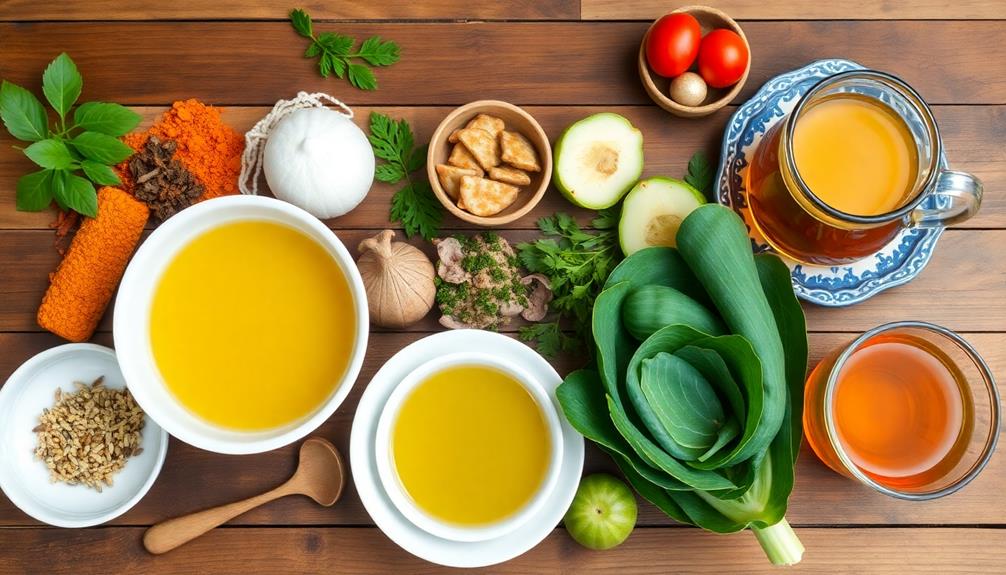
Different cultures offer unique perspectives on detox foods, shaped by their traditions and beliefs. For instance, Ayurveda promotes herbal treatments and spices to cleanse the body, while traditional Chinese medicine emphasizes foods like goji berries for liver support. In Japan, fermented foods enhance gut health, and Mediterranean diets focus on whole foods for detox benefits. Indigenous practices often incorporate natural plants in rituals. Modern detox trends can sometimes lean toward commercialization, often missing cultural depth. Each culture provides valuable insight into healthy approaches, and there's so much more to explore about these fascinating detox practices if you look closer.
Key Takeaways
- Ancient civilizations utilized fasting and herbal remedies, forming the foundation of modern detox practices emphasizing fresh, nutrient-rich foods.
- Ayurvedic practices in India and Chinese medicine employ specific herbs and foods to support detoxification and balance bodily energies.
- Indigenous cultures often incorporate spiritual rituals and natural plants in their detox processes, highlighting a holistic approach to cleansing.
- Nutritional science supports detoxification through hydration, fiber-rich foods, and superfoods that enhance the body's natural detox processes.
- Globalization has influenced detox trends, blending traditional practices with modern dietary choices, often leading to the commercialization of detox foods.
Historical Perspectives on Detox

Throughout history, various cultures have embraced detoxification as an essential practice for maintaining health. You'll find that ancient civilizations like Egypt, Greece, and China utilized fasting and herbal remedies to cleanse the body of impurities.
These early practices laid the groundwork for modern dietary practices centered on detoxification. For instance, the use of fresh, nutrient-rich ingredients, such as those found in Nettle and Potato Soup, reflects a commitment to health and wellness that resonates with detox principles.
In Ayurveda, detoxification plays a vital role, emphasizing the balance of energies and the removal of toxins known as "ama" through specific dietary practices and herbal treatments.
Fast forward to the early 20th century, and you'll notice the rise of detox diets in Western cultures. Influenced by health movements advocating natural foods, these diets aimed to promote holistic wellness.
Additionally, cultural traditions like Japan's seasonal eating highlight the importance of fresh, local foods, which support the body's natural detoxification processes throughout the year.
Today, while contemporary detox trends often draw from these historical practices, they've also transformed into commercialized diets and products. Unfortunately, many of these lack robust scientific validation for their efficacy.
Understanding these historical perspectives can offer valuable insights into the evolution of detoxification practices across cultures.
Traditional Detox Practices Worldwide

Traditional detox practices around the world reflect a deep understanding of the body's need for balance and purification. In India, Ayurvedic practices utilize a regimen called Panchakarma, where you can experience herbal treatments, oil massages, and dietary modifications aimed at cleansing toxins from your body.
Additionally, traditional Indian meals like Mushroom Masala can provide a vegetarian-friendly option that isn't only delicious but also supports the detox process through its rich blend of spices.
Meanwhile, Chinese medicine promotes specific food practices, like consuming chrysanthemum tea and goji berries, believed to enhance liver function and support detoxification.
In Native American cultures, purification rituals incorporate natural plants and herbs such as sage and sweetgrass, emphasizing both physical and spiritual detoxification.
The Mediterranean diet, rich in fruits, vegetables, and olive oil, provides antioxidants that help your body eliminate toxins while boosting liver health.
Japanese culture highlights the importance of fermented foods like miso and natto, which not only improve gut health but also facilitate detoxification through better digestion.
Each of these traditional practices showcases unique food practices that promote a holistic approach to detoxification, emphasizing the importance of natural ingredients in maintaining overall well-being.
Modern Interpretations of Detox Foods
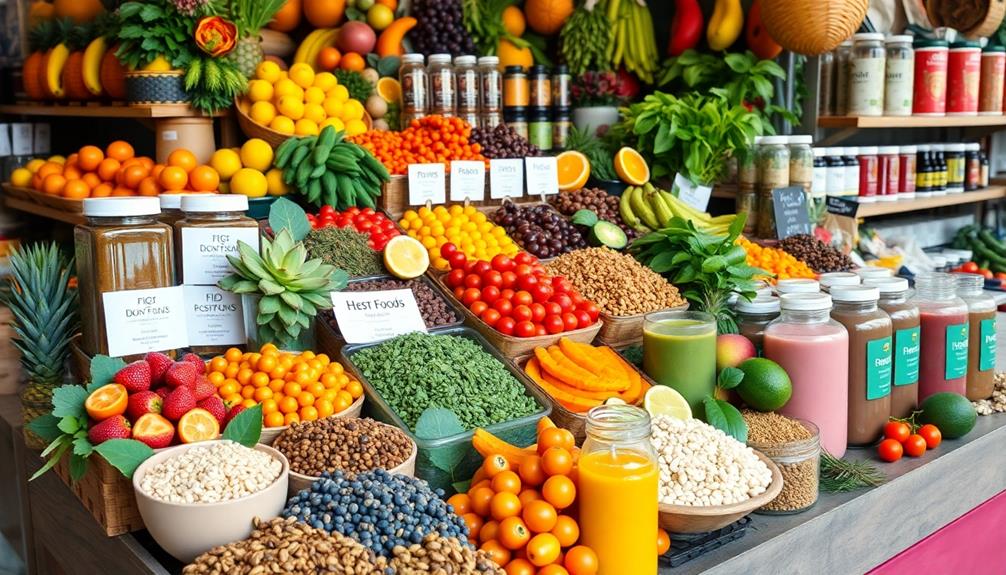
In today's health-conscious world, modern interpretations of detox foods focus on integrating nutrient-dense superfoods into your diet. You're likely to encounter recommendations that emphasize whole, organic options while steering clear of processed foods and unhealthy fats. This approach aims to enhance your body's natural detoxification processes and support overall well-being.
For instance, incorporating dishes like Red-Braised Pork Belly, which features slow-braised pork rich in flavor, can provide a satisfying balance when enjoyed in moderation.
Here are four key components of modern detox practices:
- Superfoods: Incorporate nutrient-rich foods like spirulina, chlorella, and kale, which are believed to aid in detoxification.
- Hydration: Prioritize water and herbal teas to help eliminate toxins and maintain bodily functions.
- Fruits and Vegetables: Fill your plate with a variety of fruits and veggies to support liver and kidney health.
- Elimination of Processed Foods: Cut back on processed foods to reduce your intake of unhealthy fats and additives.
While detox juices and supplements are gaining popularity, remember that their short-term results may not lead to sustainable health benefits.
Instead, focus on integrating these practices into your daily routine for lasting effects on your overall wellness.
Nutritional Science and Detoxification
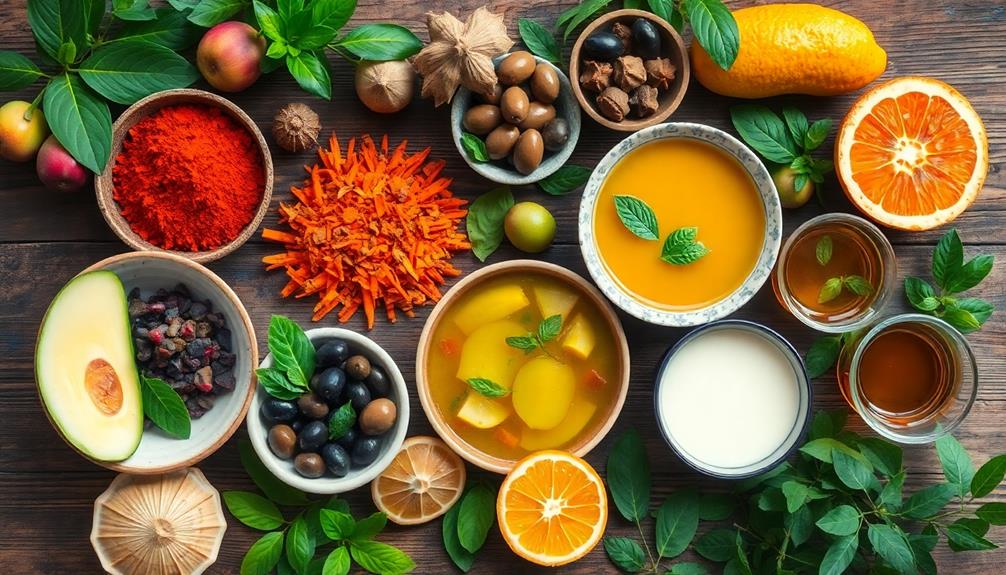
Detoxification isn't just a trendy buzzword; it's a fundamental process your body performs daily. Your body constantly works to eliminate toxins through organs like the liver, kidneys, and lymphatic system. To support this natural process, you can incorporate certain superfoods into your diet. These foods are packed with essential nutrients that enhance your body's ability to detoxify.
Here's a quick look at some superfoods and their detox benefits:
| Superfood | Detox Benefits |
|---|---|
| Spirulina | Rich in antioxidants, supports liver function |
| Kale | High in fiber, aids in digestion and toxin elimination |
| Berries | Packed with vitamins, help reduce inflammation |
Hydration is also key. Drinking plenty of clean water and herbal teas helps flush out toxins and maintains ideal kidney function. Plus, dietary fiber from fruits, vegetables, and whole grains promotes regular bowel movements, which is essential for excreting waste. By understanding the nutritional science behind detoxification, you can make informed choices that enhance your body's natural processes.
Cultural Beliefs Shaping Detox Choices
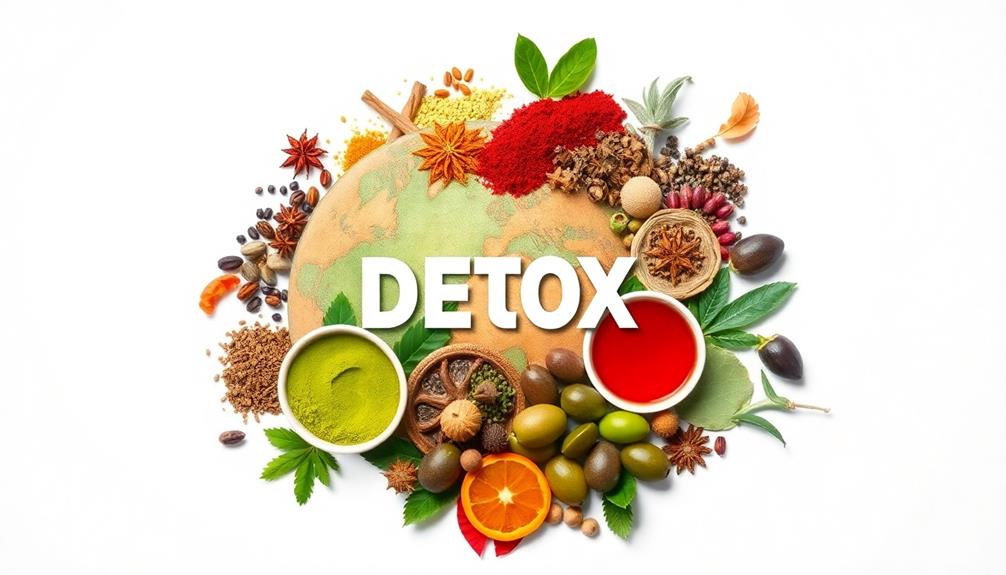
Cultural beliefs play a big role in how you choose detox foods.
While some traditions emphasize herbal teas and broths, others focus on superfoods like wild berries and roots that connect to local identities.
Understanding these practices can help you appreciate the rich tapestry of detoxification methods around the world.
Traditional Detox Practices
Many traditional detox practices reflect deep-rooted beliefs about health and wellness, showcasing how different cultures approach the idea of cleansing the body. You might find it fascinating how these practices often center around specific food consumption and natural remedies.
Here are some notable examples:
- Ayurvedic Practices: Emphasizing seasonal cleansing diets, these traditions utilize spices like turmeric and ginger to aid digestion and eliminate toxins.
- Japanese Methods: Incorporating fermented foods like miso and natto, these practices focus on probiotics that promote gut health and natural detoxification.
- Indigenous Rites: Fasting or consuming sacred plants and fruits often forms part of spiritual and physical cleansing rituals in many indigenous cultures.
- Mediterranean Diet: This approach emphasizes whole, organic foods, such as fruits, vegetables, and olive oil, believed to enhance the body's natural detoxification pathways.
Superfoods Across Cultures
Superfoods play a pivotal role in diverse culinary traditions, shaping how various cultures approach detox and wellness. In many regions, you'll find superfoods like spirulina and chlorella celebrated for their detoxification properties, often incorporated into daily diets for their health benefits.
Japanese cuisine emphasizes seasonal fruits and vegetables like seaweed and miso, which are believed to support the body's natural detoxification processes.
Latin American cultures turn to nutrient-rich foods such as amaranth and chia seeds, known for their high fiber content, to enhance digestion and promote effective detoxification.
Meanwhile, in India, Ayurvedic principles highlight spices like turmeric and ginger, regarded as essential for their anti-inflammatory and detox-supporting qualities, making them staples in cleansing diets.
African cultures also embrace superfoods like moringa and baobab, lauded for their nutrient density and antioxidant properties, integrating them into traditional meals for health enhancement and detoxification support.
Impact of Globalization on Detox Trends
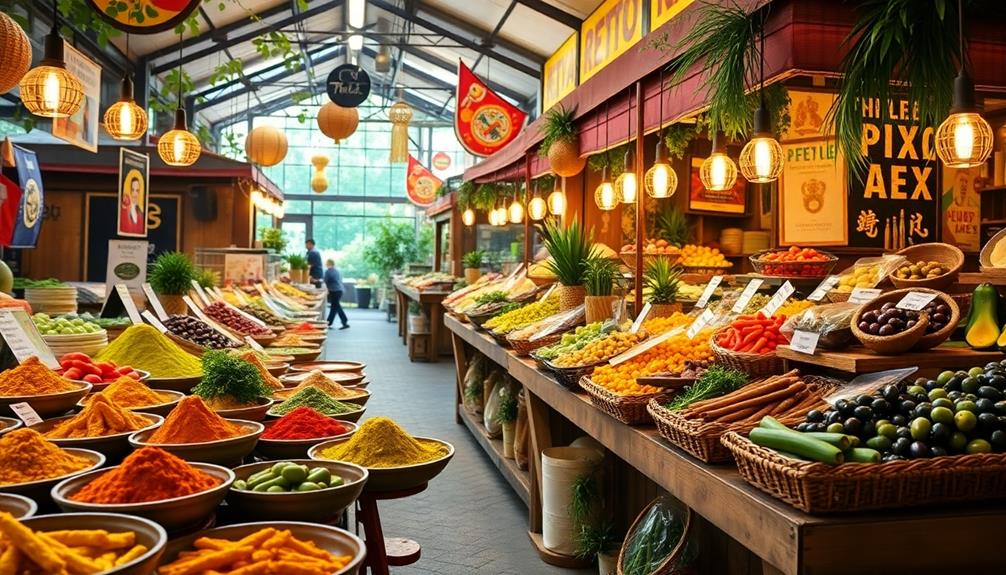
Embracing globalization has transformed detox trends, making them more accessible and appealing to diverse cultures worldwide. You might notice that detox products are now readily available, but this shift comes with both benefits and challenges.
Here are some key impacts of globalization on detox trends:
- Widespread Access: Detox products are easier to find than ever, allowing individuals from various backgrounds to explore these health practices.
- Social Media Influence: Platforms like Instagram and TikTok have accelerated the popularity of detox diets, shaping dietary choices across different cultures.
- Conflict with Traditional Values: As cultures adopt Western dietary practices, processed detox foods often replace traditional food, undermining local culinary heritage.
- Commodification of Culture: Global marketing can dilute the significance of traditional foods, emphasizing quick fixes over sustainable practices that promote long-term health.
While globalization introduces you to novel detox approaches, it's essential to remember the value of traditional food practices.
Striking a balance between embracing new trends and honoring your cultural roots can lead to a healthier, more meaningful detox experience.
Detox Foods in Popular Diets
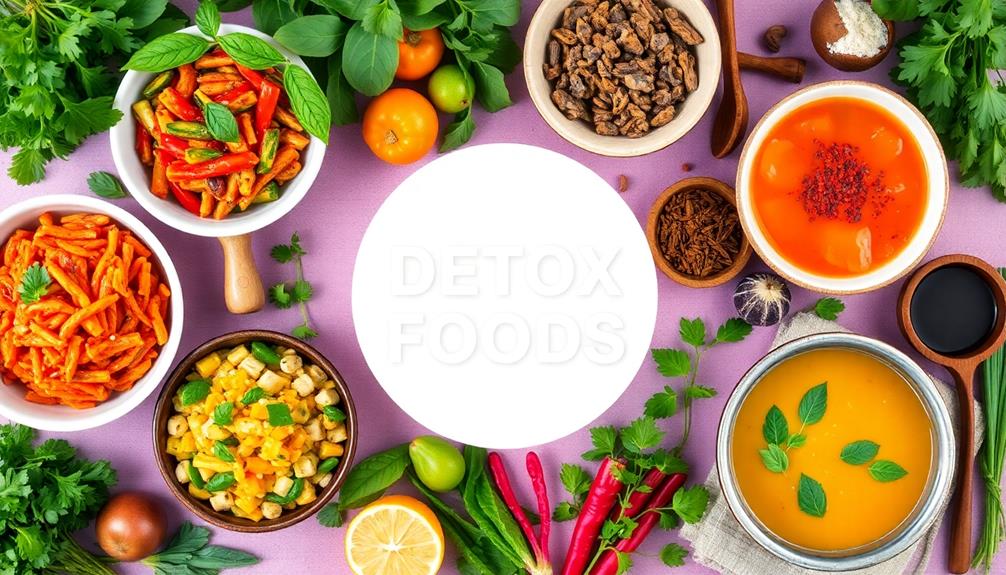
Detox foods play an essential role in popular diets, offering a range of options that promise to enhance your health and well-being. Many of these diets emphasize superfoods like kale, spirulina, and berries, which are packed with crucial nutrients that support your body's natural detoxification processes. You'll often find that these programs advocate for cutting out processed foods and allergens to help reduce toxin buildup.
Juice cleanses are another trendy option, where you consume only fruit and vegetable juices for a set period. Advocates claim this approach can reset your digestive system and promote weight loss. The ketogenic diet also incorporates detoxing elements, focusing on healthy fats and low-carbohydrate foods that can lower insulin levels and encourage fat burning.
Here's a quick overview of some popular detox foods and their associated eating patterns:
| Detox Foods | Eating Patterns |
|---|---|
| Kale | Superfood-focused meals |
| Fruit & Veg Juices | Juice cleanse regimes |
| Healthy Fats | Ketogenic meal plans |
Health Benefits Across Cultures

When you explore detox practices around the world, you'll find that traditional methods often focus on natural ingredients to enhance health.
In many cultures, incorporating nutrient-rich superfoods like ginger, spirulina, and nopal cactus is believed to boost energy and support digestion.
Understanding these diverse approaches can help you appreciate the holistic benefits of detoxification.
Traditional Detox Practices
Across various cultures, traditional detox practices offer unique insights into promoting health and well-being. These methods highlight the importance of detoxification through natural means, often utilizing the wisdom of generations past.
Here are four notable practices you might find beneficial:
- Ayurvedic Panchakarma: This regimen combines dietary changes, herbal treatments, and therapeutic massages to cleanse the body and restore balance.
- Japanese Seasonal Foods: Ingredients like daikon radish and pickled vegetables are emphasized for their digestive health benefits, aiding in toxin elimination.
- Native American Sweat Lodges: This practice uses steam and heat to promote sweating, believed to release impurities and enhance physical and spiritual health.
- Traditional Chinese Medicine Broths: Warm, cooked foods, especially broths and teas made from ginger and garlic, support digestion and enhance the body's detoxification capabilities.
These traditional practices reflect a deeper understanding of how food and natural therapies can contribute to overall health.
Nutrient-Rich Superfoods
Exploring traditional detox practices naturally leads to the importance of incorporating nutrient-rich superfoods into your diet. These foods aren't just trendy; they play a crucial role in supporting your body's detoxification processes.
For instance, in many cultures, spirulina and chlorella are celebrated for their high levels of vitamins and minerals that enhance detoxification.
Japanese cuisine emphasizes fermented foods like miso and natto, which are packed with probiotics that improve gut health and help eliminate toxins effectively.
Meanwhile, traditional Indian diets often feature turmeric, a powerful superfood known for its anti-inflammatory properties that support your body's natural detox pathways.
Berries, rich in antioxidants, are consumed worldwide for their ability to combat oxidative stress and promote liver health—an essential organ in detoxification.
Additionally, leafy greens like kale and spinach are staples in various diets, providing essential nutrients and fiber that facilitate digestive health and toxin removal.
Sustainable Approaches to Detoxing
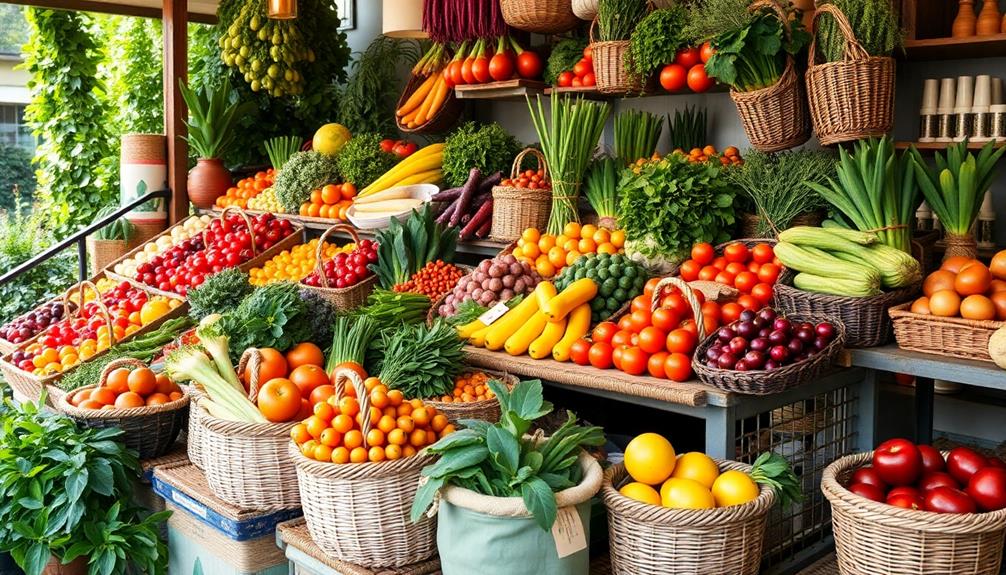
How can you detox sustainably without resorting to extreme diets? The key lies in embracing whole, unprocessed foods that nourish your body and support its natural detoxification processes. You don't need quick fixes; instead, focus on long-term health through mindful eating.
Consider these sustainable approaches to detoxing:
- Incorporate Superfoods: Add nutrient-dense options like spirulina, chlorella, and kale to your meals. They enhance detoxification and promote well-being.
- Stay Hydrated: Drink plenty of water and herbal teas to help your body eliminate toxins effectively. Hydration is vital for a successful detox.
- Reduce Processed Foods: Cut down on foods high in unhealthy fats and additives. This shift not only supports detoxing but also helps improve your overall health.
- Cultivate a Positive Body Image: Focus on nourishing your body rather than temporary weight loss goals. A healthy relationship with food is essential for sustainable eating.
Frequently Asked Questions
How Are Food Choices Influenced by Culture?
Your food choices reflect your cultural background, shaping your preferences and beliefs. Traditions, values, and communal practices influence what you eat, guiding you toward certain ingredients, cooking methods, and dietary patterns that resonate with your identity.
How Do Culture and Ethnicity Play a Role in Dietary Intake?
Culture and ethnicity shape your dietary intake by influencing what foods you value, how you prepare them, and the communal practices around eating. These factors determine your perceptions of health and wellness in food choices.
What Are the Cultural Beliefs About Food?
You'll find that cultural beliefs about food shape your eating habits considerably. They influence what you consider healthy, how you prepare meals, and the rituals surrounding food, all reflecting your community's values and traditions.
What Are the Cultural Influences on the Mediterranean Diet?
Did you know that Mediterranean countries boast some of the world's longest life expectancies? You'll find cultural influences in communal meals, local ingredients, and traditional cooking methods, all promoting health and connection through food.
Conclusion
In exploring how different cultures approach detox foods, you've uncovered a rich tapestry of beliefs and practices. As the saying goes, "You are what you eat," highlighting the importance of making mindful choices. From ancient traditions to modern interpretations, understanding these diverse perspectives can enrich your own wellness journey. By appreciating cultural nuances and adapting sustainable practices, you can cultivate a balanced approach to detoxing that resonates with your unique lifestyle and values.
-

 Vetted6 months ago
Vetted6 months ago14 Best Personalized Father's Day Gifts for Your Husband – Show Him You Care
-

 Alfresco5 months ago
Alfresco5 months agoAlfresco Stacker Doors: Seamless Indoor-Outdoor Living!
-

 Vetted6 months ago
Vetted6 months ago15 Best EMS Foot Massagers for Neuropathy to Soothe Your Feet
-

 Craft and Textiles7 months ago
Craft and Textiles7 months ago15 Best Places to Buy Appliances for Your Home – Top Retailers Reviewed
-

 Vetted5 months ago
Vetted5 months agoBattle Born Batteries Review: Reliable Power Solution
-

 Tableware and Dining Accessories7 months ago
Tableware and Dining Accessories7 months agoWhat Is the Meaning of the Word Tableware
-

 Vetted5 months ago
Vetted5 months agoD-Link Switch Review: Lite Layer 3 Managed Networking
-

 Tableware and Dining Accessories7 months ago
Tableware and Dining Accessories7 months agoWhen Is Tableware on Sale at Hobby Lobby





























